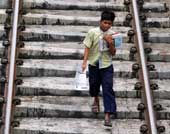|
|
Cleaning up is necessary, satisfying and cruel. When it involves removing unwanted human beings for the safety, comfort and hygiene of more important human beings, it becomes a difficult and complicated operation. A ready way to start going about it is to use the law: make a new law or dredge up an old one that would redefine the unwanted as the illegal. But laws have to be implemented — by human beings upon human beings. In a country of well above a billion people, about a quarter of whom are below the poverty line and a third illiterate, doing this in the face of ethics, politics and the sheer scale of things approaches the impossible. And the twin pillars of democracy and development do not make the job any the less complicated.
The Calcutta high court’s recent attempt to galvanize Eastern Railway into tidying up its trains and platforms by removing beggars and unauthorized hawkers ran into precisely these difficulties. The court, in response to a distressed passenger’s PIL, invoked the Railways Act, 1989, which outlaws beggars and unlicensed hawkers, and got the state government’s endorsement. But the Paschim Banga Railway Hawkers’ Union — supported by the CPI(M)’s labour wing, Citu — was galvanized into another kind of action on behalf of the 50,000 illegal hawkers and the 8,00,000 people who depend on their income, according to the union’s estimates. The court was firm for a while, as the railway authorities tried to buy time. Then it relented by allowing the latter some time to come up with a proper “rehabilitation policy” for the evicted. This is how things stand now.
In India, the grey zone between half-forgotten laws and undelivered policies teems with such obstinate multitudes. They are illegal to the courts, inconvenient for the authorities, necessary for the parties and their unions, and annoyingly or usefully “paralegal” to passengers and social scientists. It becomes natural, therefore, to think of them, or even to ‘see’ them, as collectives or categories — hawkers, beggars — divested of history and identity, and hence, of rights and needs. Their presence is acknowledged when counting them up for surveys, and when they have to be represented in the respective jargons of law, policy, unions and quotas. Against this Many is the One: the proper, rights-bearing citizen, protected by law and the State, and by the legitimate codes and customs maintaining his private and public roles and spaces. Yet these two worlds have always cohabited in actual space, even if the ‘unorganized’ and hence, invisible, symbiotic exchanges between them are seldom measured and spoken up for.
If Eastern Railway had managed to obey the court order, what kind of people would have been evicted from their habitat or workplace? There are the more vocal hawkers and entertainers, mostly men, who seem to have ‘made it’. The measure of their success is the extent to which they are backed by their union. But outside this band of resourceful men, is a vast penumbra of women, runaway or abused children, and perhaps most important, a significant number of blind and severely crippled people, or people suffering from incurable diseases that are also often infectious.
These are some of the country’s most vulnerable and, in every way, unrepresented people, thrown to their own resources in devising what they do for a living, so that it is somehow an act of commerce rather than of begging, and so regarded as useful in some way. They often confound the welfare categories. Are they going to be Hawkers or Beggars, and therefore Offenders? Or are they going to be Women, Children, the Disabled and the Handicapped, categorizable under different policy and welfare headings, within the purview of different commissions and ministries?
By calling them all beggars, vast lacunae in the state and Central governments’ infrastructure remain unaccounted for, together with enormous sums of allocated money. In the case of the children, for instance, the railways are bound by law to categorize them, under the existing Juvenile Justice Act, as either “juveniles in conflict with law” or as “children in need of care and protection”, each having its due process that involves juvenile courts, child welfare boards and government observation homes. And this is just one infrastructural requirement, apart from those relating to education and health that will have to be taken into account in order to work out a “rehabilitation package” for the children. And the same might be said of the women and the disabled. In every such instance, and at every level, once the beggars and offenders become people with faces, stories and claims, what will have to be reckoned with are monumental and pervasive failures on the part of the State. The eternal cycle of PIL, followed by eviction order, suspended until rehabilitation, is the best way to let things stand as they are. Perhaps, this is by far the most ‘humane’ option — in the most bizarre and brutal sense of that convenient word.


